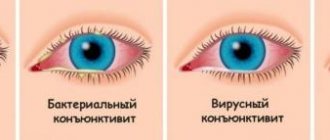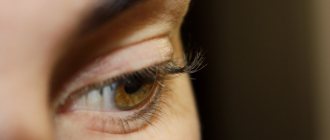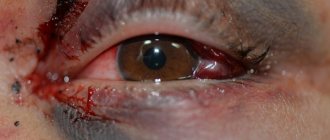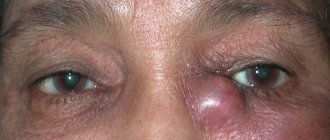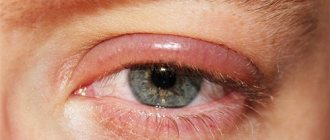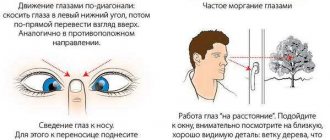Main causes of photophobia
The most common causes that can cause photophobia of the eyes in adults are:
- Conjunctivitis is an inflammation of the ocular conjunctiva, accompanied by pain and pain in the eyes, redness of the whites of the eyes, and sometimes the formation of pus (if the disease is bacterial in nature);
- Iritis – inflammation of the iris of the visual organ;
- Keratitis – inflammation of the cornea;
- Mechanical damage to the cornea;
- Formation of ulcers or tumors in the eye area;
- Albinism is a disease in which light rays penetrate not only through the pupils, but also through the discolored iris;
- Frequent, prolonged migraines;
- Colds;
- Prolonged exposure to sunlight;
- Eye irritation resulting from violation of the rules of staying in a solarium;
- Congenital photophobia, accompanied by partial or complete absence of the pigment substance melanin;
- Drug treatment of various diseases;
- Daily long stay at the computer;
- Exposure of the eyes to prolonged exposure to bright light;
- Acute attack of glaucoma;
- Corneal erosion caused by a foreign object entering the eye cornea;
- Examination of the fundus followed by artificial dilation of the pupil;
- Viral and infectious diseases such as measles, rabies, botulism;
- Photophobia can also be a side effect of taking furosemide, quinine, doxycycline, belladonna, tetracycline, etc.;
- Retinal detachment;
- Thermal or sunburn of the eyes;
- Surgical interventions in the area of the visual organs (one or both);
- Spending a long time in a dark room, after which bright lighting suddenly appears (such changes lead to the fact that the pupil simply does not have time to adapt to new conditions; this is a completely normal phenomenon, so it should not be perceived as a deviation).
Photosensitivity is a fairly common anomaly in people wearing contact lenses. But such a deviation does not always occur, but only if they were incorrectly selected. In such a situation, irritation of the cornea occurs, which can also cause tearing and pain in the eyes.
There is no need to worry if photophobia occurs due to prolonged exposure to a dimly lit room. After the sudden appearance of bright light, the eye does not have time to adapt to the new conditions, which can cause pain, pain and black spots (or dots). A similar deviation is observed in people who are accustomed to reading or working at a computer for a long time, as well as after waking up. But if photophobia is a constant symptom that does not disappear over a long period of time, this should seriously alert the person and force him to consult an ophthalmologist.
Possible disorders accompanied by flickering in the eyes
Vascular diseases. With hypertension and diabetes, patients constantly complain of flashes in the eyes. This happens when there is a sudden change in lighting or simply when your eyes are closed. Such flickering indicates short-term spasms and poor circulation in the retina
Considering that the development of diseases begins with a flicker in the eyes in the dark, I advise you to first of all pay attention to the problem of vascular diseases. Retinal tears and detachment
Often, flashes or flickering in the eyes (not only when the lighting changes) are a symptom of the onset of retinal detachment. Most often they appear after physical exertion or due to severe stress, when the patient, in addition to flickering, has a veil before the eyes or even a sharp drop in vision. These symptoms cannot be ignored, and the disorder requires immediate treatment. Posterior vitreous detachment. “Vitreous humor” is the gel-like substance that fills the central part of the eye. The vitreous body is attached to the retina, and over the years the process of its detachment may begin. Thus, pressure begins to be exerted on the retina of the eye, which leads to flashes and flickering in the eyes. Most often it can appear when moving the eye. With this violation, the main thing is not to waste time, because delay can lead to a serious complication - complete retinal detachment, which, in turn, threatens vision loss. Migraine. With the development of this disease, the next attack may be accompanied by preliminary symptoms - flickering and flashes in the eyes. Sometimes migraine attacks are painless only against the background of flashes and flickering in the eyes. This type of migraine is called an “ocular” migraine. Eye or head injuries. Quite often, it is after injuries that a person develops problems with the eyes, which are characterized by periodic flashes, the appearance of “midges” and flickering.
Treatment of the disorder occurs only after the root cause has been determined. The disease “flicker in the eyes” does not exist in itself. This symptom is only a consequence of the development of a certain disease, so you can get rid of it only after the ophthalmologist establishes the cause and prescribes active therapy for the underlying disease. You may have to consult another doctor if the essence of the problem lies outside the scope of the ophthalmologist’s competence. But one thing is certain: the disease should not be hushed up, especially since “innocent” symptoms may indicate the development of irreversible complications.
Treatment
When contacting a medical institution with a problem of photophobia, the ophthalmologist will definitely diagnose eye diseases. If photophobia is accompanied by fever, vomiting or allergic manifestations, you should also visit an infectious disease specialist or therapist to find out the cause.
Medically
It is useless to treat photophobia without identifying the cause and underlying pathology. Very often, this symptom goes away on its own when the irritating factor is eliminated or after recovery from the underlying disease. Photophobia can be reduced by wearing dark sunglasses and anti-inflammatory eye drops. Such measures will help reduce discomfort and lead a normal lifestyle during the treatment of the underlying disease.
Treatment of photophobia of the eyes depends on the reasons that cause it. If increased sensitivity to light has developed due to an inflammatory disease of any part of the eyeball, then after eliminating the source of inflammation, photophobia will go away on its own.
For purulent discharge, it is necessary to use drops with antiseptics or antibiotics, for example, Okomistin, Levomycetin drops, Tobradex, etc.
If photophobia occurs as a result of a bruise, injury or burn to the eye, urgent ophthalmological assistance will be required. You can first drip your eyes with antiseptic drops and apply a sterile bandage on top.
In the case when such a disorder is associated with the entry of a foreign body or contamination, then after eliminating the negative factor and rehabilitation of the injured organ, the disease can also go away on its own.
Sometimes photophobia is caused by the development of any infectious diseases that are not related to the functioning of the visual system and its normal functioning. In this case, treatment should be aimed at treating the underlying disease that provoked photophobia.
If photophobia is caused by taking certain medications, then the doctor will select an analogue that will not provoke such a reaction to light.
In cases of congenital photophobia or associated with environmental factors, the doctor may recommend wearing contact lenses that minimize negative reactions to light.
Folk remedies
Eye diseases can be treated not only with medications, but also with traditional methods. We offer several recipes that can eliminate or reduce discomfort, including the symptom of photophobia:
- Compress and infusion of Potentilla erecta. This plant helps cure many eye diseases, including eliminating photophobia, as well as improving vision. To prepare a compress, you will need 1 teaspoon of herb, which needs to be filled with 200 ml of water. The broth should be brought to a boil, then let it brew for 3 hours. You should rinse your eyes with this infusion before going to bed. A compress will also have a good effect. Soak sterile gauze wipes with the infusion and apply to your eyes for half an hour.
- Sweet clover compress. The flowering tops of this plant should be collected in July. Pour 40 g of sweet clover with 200 ml of water and boil over low heat for 15 minutes. Cool the product, strain and apply swabs soaked in it in the morning and evening for 30 minutes.
- Drops on “silver water”. Boil and cool water, pour into a glass jar. Place some silverware there (coins or cutlery). Leave the water for a week, during which time it will become enriched with silver ions. Then take 4 large aloe leaves (the plant must be over 3 years old) and place in the same container. Bring the water to a boil, remove from heat, and wrap the pan in a large towel and blanket. The remedy should be infused until the morning. Strain the broth in the morning, then add 2 teaspoons of natural honey and stir until completely dissolved. Place 2 drops in each eye 3 times a day. The course of treatment ranges from 1 week to six months. Such drops will relieve photophobia, eye inflammation, cataracts, and also improve vision. They need to be stored in the refrigerator.
- Sea buckthorn oil. It will help get rid of photophobia. The first two days you need to drop 1 drop of oil into the eye every 2 hours. And then 2 drops up to 3 times a day. It can also be used for compresses. Soak cotton pads in sea buckthorn oil and apply to eyelids for half an hour, 2 times a day.
- Calendula with chamomile. Mix calendula and chamomile flowers. Pour a spoonful of the mixture with boiling water (250 ml) and leave for 1 hour. Strain the infusion. Rinse your eyes several times a day or use the infusion for compresses. You can also drop the product into your eyes, 2 drops 3 times a day.
Preventing the occurrence of increased photosensitivity
There are a number of special requirements that must be met to prevent the occurrence of increased photosensitivity of the eyes, as well as any other diseases of the organ of vision, including a gradual decrease in its acuity. In particular, these rules should be paid attention to by those people who have a profession related to working on a computer, as well as those whose relatives suffered from eye diseases. It is necessary to constantly monitor your hand hygiene. Avoid rubbing your eyes with unwashed hands, as well as dirty or someone else’s handkerchiefs, towels, etc.
Wash your hands regularly with soap
There is a certain category of professions associated with a negative impact on human vision. One of these professions is a welder. When working with welding, you must follow all safety rules and perform the work in a special protective mask or safety glasses.
If a person experiences constant dry eyes, especially in the evening, it is necessary to use special drops, which are completely identical in composition to the composition of human tears. People who have a profession that involves constant work at a computer are usually more susceptible to dry eyes. The use of drops containing “artificial tears” will help avoid inflammation of the eye.
"Artificial tear"
It is necessary to carry out daily therapeutic exercises for the eyes. The ophthalmologist should familiarize the patient with these exercises, selecting an individual list of exercises for each patient depending on the state of his vision and diagnosis.
Gymnastics for the eyes
When going outside in the summer, you need to protect your vision with dark glasses that properly protect your eyes from direct sunlight. It is important to avoid contact of unprotected eyes with the sun. It must be remembered that glasses not purchased in specialized stores will not be able to properly protect your eyes from sunlight .
How to choose sunglasses?
If you notice symptoms or discomfort in your eyes, you should immediately get diagnosed by an ophthalmologist. It must be remembered that various pathologies and degenerative destruction of eye tissue can be stopped only in the early stages of their occurrence. This is why early diagnosis of eye diseases is very important.
It is also necessary to remember that the use of various folk recipes in the fight against photosensitivity or any other symptoms is undesirable, since such treatment may not only fail to produce results, but also lead to more serious consequences.
Gymnastics for the eyes
Symptom therapy
Treatment of photophobia is entirely based on the cause of this symptom. This requires ophthalmological diagnosis, since many eye diseases are similar to each other. To make a diagnosis, the following studies are needed:
- Ophthalmoscopy – examination of the fundus through a previously dilated pupil.
- Biomicroscopy - examination in a special slit lamp for changes in the vitreous body and areas of the fundus.
- Perimetry - checking visual fields.
- Tonometry is the measurement of intraocular pressure.
- Gonioscopy is an examination of the corner of the eye where the iris borders the cornea.
- Pachymetry is the measurement of corneal thickness.
- Ultrasound of the eye helps to examine the transparent media of the eye when it is impossible to perform ophthalmoscopy.
- Fluorescein angiography is a study of the patency of blood vessels that supply the structures of the eye.
- Optical coherence tomography - helps to identify changes in retinal tissue.
- Electroretinography - helps to carefully study the functioning of the retina.
- Sowing the discharge from the conjunctival sac for viruses (using the PCR method), bacteria and fungi.
If, according to the results of an ophthalmological examination, a person is healthy, an examination by a neurologist is necessary. This specialist also prescribes additional studies:
- MRI of the brain;
- electrocephalography;
- Dopplerography of the vessels of the neck, which are directed into the cranial cavity.
An ultrasound of the thyroid gland, determination of hormones produced by this gland in the blood, and radiography of the lungs are also prescribed. If signs of hyperthyroidism or diabetic retinopathy are detected, treatment is carried out by an endocrinologist. If there is evidence of a tuberculous process in the cornea and conjunctiva, therapy is prescribed by a phthisiatrician.
What can you do before consulting a specialist?
We do not recommend delaying contacting a doctor, as seemingly banal photophobia may hide a malignant brain tumor that is rapidly progressing. But while you're waiting for your appointment with a doctor or for a test, you don't have to suffer from daylight. To alleviate the condition, buy polarized sunglasses, which will make it possible to reduce the dose of ultraviolet radiation entering the eye. In addition you need:
- stop rubbing your eyes;
- reduce time spent sitting at the computer;
- use Vidisik drops containing artificial tears;
- for purulent discharge, use drops with antiseptics or antibiotics: “Okomistin”, “Levomycetin drops”, “Tobradex” and others. In this case, an examination by an ophthalmologist is mandatory, since the purulent process can affect the deeper parts of the eye, which the local antiseptic “does not reach”;
- If photophobia appears as a result of a bruise, injury or burn to the eye, emergency ophthalmological assistance is needed. First, apply antiseptic drops to your eyes, apply a sterile bandage on top, and call an ambulance.
Diagnosis of the disease and its prevention
To exclude all organic brain injuries (intracranial hematomas, tumors and hydrocephalus), the patient uses MRI
If you suspect complications when bearing a child, it is important to donate blood for a biochemical test (urea and creatine) and urine, in which protein can often be detected, which indicates disturbances in the normal functioning of the kidneys
The electroencephalogram is very important for assessing the rate of excitation of the cerebral cortex, determining the location of the ectopic lesion that causes epileptic seizures and fear of light. If a doctor diagnoses heleophobia, the patient visits a psychiatrist.
When conducting diagnostics, it is very important to exclude alcohol intoxication and drugs, as well as conduct tests for the presence of such substances in the patient’s blood. There is no need to suffer from bright daylight at all before going to the doctor.
To alleviate your general condition, you need to purchase special polarized sunglasses that will help reduce the amount of ultraviolet radiation reaching the retina. You also need:
There is no need to suffer from bright daylight at all before going to the doctor. To alleviate your general condition, you need to purchase special polarized sunglasses that will help reduce the amount of ultraviolet radiation reaching the retina. You also need:
- reduce the number of hours per day working at the computer;
- stop rubbing your eyes too much;
- use Vidixic drops, which are considered a good means of artificial tears;
- if there is purulent discharge in the eyes, it is best to use special drops with antibiotics or antiseptics Tobradex, Okomistin, chloramphenicol drops. With all this, the attending physician must carefully examine the patient, since purulent processes can also affect the deeper layers of the eye, to which the local agent simply will not reach;
- If photophobia appears due to a burn, bruise or injury to the eye, then the patient should be immediately provided with ophthalmological care. First, you should drip the eyeball with drops containing an antiseptic effect, and apply sterile gauze to the eye.
There is no need to wait long before seeking help from a treating specialist, otherwise such a seemingly insignificant reason can provoke the development of a malignant tumor in the brain, which will begin to progress rapidly.
Attention, TODAY only!
A symptom such as photophobia gives a person a lot of unpleasant sensations. In this case, any ray of light, daylight or artificial, on the area of the eyeball brings a feeling of discomfort, and sometimes even acute pain. Sometimes this manifestation is accompanied by lacrimation (or both at once) and redness of the eyes. What are the causes of photophobia? What to do in this case?
Full sleep
To look fresh and alert, you need to sleep at least 8 hours a day. During this time, your body will have time to rest and gain strength. The eyes, like any other organ, need proper sleep. Constant lack of sleep causes redness, overstrain of the eye vessels and a tired appearance. If you want to be young and beautiful, do not neglect sound and healthy sleep.
Lost weight: what Sofia Tarasova sacrificed for the sake of “VIA Gra” (new photos)
Women's jeans: before you buy them, you need to pay attention to one detail
A student at the Vietnam Police Academy shared how she takes care of her facial skin.
Causes
At times, photophobia can occur due to strain on the eyes. When exposed to light after being in a dark room or after spending a long time in front of a computer screen. In such cases, photophobia is short-lived and does not pose any threat.
But if the painful reaction continues for a long time, urgent medical examination is necessary, because in this case photophobia is the result of an illness or injury to the eyes.
List of diseases that can lead to photophobia:
Conjunctivitis. Iritis and other diseases in which any part of the eye becomes inflamed; Structural features and congenital pathologies of the visual organs - albinism or melanin deficiency; Mechanical damage to the eye or ingress of foreign bodies, irritation from contact lenses; Neoplasms in various parts of the eye; Diseases that affect the brain (rabies); Migraine; Mercury poisoning; Side effects of certain medications (quinine, tetracycline); Retinal detachment. chemical or sunburn.
As can be seen from the list above, photophobia can be a sign of a serious illness, so this pathology should not be ignored.
Since photophobia most often indicates the presence of another disease, treatment should be aimed at the disease that led to increased sensitivity of the eyes.
In the event that painful sensitivity to light is caused by congenital structural features of the eyes, or if the treatment of the pathology that caused photophobia is too long or not possible at all, it is necessary to take measures that can improve well-being.
First of all, you need to reduce the strain on your eyes: you need to darken your workplace and reduce the brightness on your computer monitor.
You should only be in the light with special glasses, which should completely protect your eyes from ultraviolet rays.
It would also be useful to wear a hat with a visor or wide brim.
If photophobia is caused by taking medications, you need to contact your doctor to change them.
Eye drops
When photophobia is episodic and not a symptom of any disease, eye drops can be used to reduce discomfort.
If this pathology is caused by excessive strain on the eyes, then you can use moisturizing drops that contain vitamins. And if photophobia occurs due to inflammatory processes, then anti-inflammatory and antibacterial drops should be used.
But do not forget that you can use any medications only with the permission of a specialist.
Tips (3)
Manechka
September 16, 2011 at 11:45 am
You need to see a specialist, since eye sensitivity in some cases can be symptoms of a disease, I don’t want to scare you, perhaps this is just a feature of your body. But nevertheless, see a doctor, only he will be able to correctly answer this question. In general, you can buy glasses with simple chameleon lenses, one of my friends did just that after they sprayed a gas canister into his eyes at a disco, and his sensitivity also increased. But don’t put off visiting the doctor!
Alexander
September 16, 2011 at 12:03 pm
Almost all people squint from bright light in winter. This is how the body limits the bright stream of light entering the pupil, because constriction of the pupil is a natural reaction to bright light; it is not enough. In winter, with clean snow, this occurs from an excess flow of light waves reflected from the white surface of the snow, exactly the same phenomenon occurs when a person is near a large open surface of water, so tanning in snow-capped mountains and near water is much more intense. Under these conditions, it is normal for a person to squint reflexively to protect the retina from being burned. And if this phenomenon (squinting) occurs in normal lighting, it is photophobia. Photophobia (photophobia) is a painful sensitivity of the eye to light, in which exposure to light causes unpleasant sensations in the eyes and causes the person to squint their eyes. Usually caused by some kind of eye disease. Photophobia can develop as a result of dilated pupils after instilling various eye drops. Also possible due to measles, rubella, meningitis, diseases of the conjunctiva and cornea (erosion, conjunctivitis). Photophobia occurs when you spend a long time in the dark or twilight. Many years of daily computer abuse also leads to this condition. Photophobia in one eye, accompanied by pain, can be caused by the presence of a foreign body on the cornea. In healthy eyes, photophobia occurs when too much light enters the eye, such as when the light is too bright. For photophobia, wearing sunglasses is recommended, with mandatory treatment of the underlying disease.
Marina
September 16, 2011 at 9:52 pm
I have the same problem) there is no reason to worry, but it creates some inconvenience, so in the summer it is more convenient to wear dark glasses.
Eye diseases
Eye diseases
– various functional and organic lesions of the visual analyzer, which limit the ability to see.
Symptoms of eye disease
• sharp pain, redness of the eyes, discharge from the eyes and photophobia indicate the presence of an infectious eye disease;
• the likelihood of developing myopia exists if objects located nearby are clearly visible, but in order to see distant objects, you have to squint and strain;
• when the cornea is damaged, a sharp, acute pain is observed, attacks of which go away with closed eyes;
• decreased vision and the presence of a veil before the eyes indicate the presence of cataracts;
• symptoms of glaucoma: increased intraocular pressure, accompanied by headaches and reduced visual field.
Types of eye diseases
1. Glaucoma is the loss of the eye's ability to regulate its internal pressure, resulting in increased pressure. Glaucoma is the most dangerous eye disease.
2. Cataract is a disorder caused by clouding of the lens of the eye.
3. Blepharitis - diseases associated with inflammation of the edges of the eyelids.
4. Conjunctivitis is an inflammation of infectious origin.
5. Leukoma – the appearance of a white spot on the cornea.
6. Keratitis – inflammation of the cornea, redness, clouding.
Symptoms
A characteristic feature of the choroid is the absence of nerve endings, so uveitis can occur for a long time without obvious symptoms and is not accompanied by pain. Manifestations of the disease depend on the cause of uveitis, the extent of the lesion, the pathogenicity of microorganisms and the state of the patient’s immune system.
Anterior uveitis in the initial stage of the disease can manifest itself as a feeling of “veil”, a slight “fog” before the eyes, which is accompanied by a feeling of heaviness in the eye and a gradual decrease in visual acuity. If the patient does not consult a doctor, as the inflammation progresses, severe redness of the eye appears, vision continues to decline, heaviness and pain in the eye intensify, photophobia, lacrimation, and increased intraocular pressure join these symptoms. In severe advanced cases of uveitis, blindness may be a possible outcome of the disease.
Posterior uveitis is characterized by late onset of symptoms, absence of pain, and no redness of the eyes. There is a gradual progressive deterioration of vision, with the appearance of a “fogginess” or “spot” in front of the affected eye. As inflammation progresses, mild dull pain in the depths of the orbit may occur. Typically, this sign indicates involvement of the optic nerve in the inflammatory process.
Surgical treatment of dry eye syndrome
Surgical intervention is resorted to in situations where drug therapy has exhausted its reserves and has proven insufficiently effective.
There are several types of surgical interventions that are used for dry eye syndrome.
Blockage of the tear ducts
To prevent tear fluid from accumulating in the arches of the eyelids, the lacrimal ducts may be blocked. As a result, when you blink, the cornea begins to be washed with tears more effectively. Most often, this surgical intervention involves blocking the lacrimal openings with special plugs, as well as their coagulation using a laser beam or an electric scalpel.
Reducing the area of tear fluid evaporation
Sometimes doctors resort to stitching the edges of the eyelids, as a result of which the palpebral fissure narrows. This helps reduce the area of tear fluid evaporation. As a rule, this intervention is carried out if simply blocking the lacrimal ducts does not help normalize the secretion of the lacrimal glands.
Implantation of additional lacrimal glands
An extremely complex, but at the same time effective method of treating xerophthalmia is the transplantation of additional mucous glands. They are implanted from the patient’s mouth into the soft tissue of the appendages of the organs of vision. The effectiveness of this surgical intervention depends mainly on the qualifications of the surgeon.
Symptoms
A person suffering from photophobia, when exposed to an illuminated space, squints, closes his eyes, and tries to protect his eyes from the light with his hands. When wearing sunglasses the situation improves slightly. Increased photosensitivity may be accompanied by additional symptoms, such as:
- Headache;
- Pupil dilation;
- Redness of the eyes;
- Feeling of “sand” or “stinging” in the eyes;
- Impaired visual acuity;
- Unclear outlines of objects.
Photophobia of the eyes is a manifestation of a painful reaction of the visual organs to daylight. In medicine, this concept is called photophobia (fear of sunlight). The disease is characterized by unpleasant sensations and squinting of the eyes when natural or artificial light penetrates them.
When you are in the dark, the feeling of discomfort disappears. All this has its own causes and is also accompanied by certain symptoms.
Preventing excessive tooth sensitivity
Some simple steps will help prevent problems or minimize their manifestations:
- Careful oral hygiene, brushing teeth with non-aggressive pastes.
- Rinse, use dental floss.
- Eating foods rich in calcium and fluoride.
- Rinse thoroughly after eating acidic foods.
- Refusal of aggressive whitening methods.
- Regular visits to the dentist.
Preventing tooth sensitivity is much easier than dealing with the problem once it has already arisen.
Reasons for the development of the lesion
The oculomotor nerve is designed to regulate the size of the pupil, thereby ensuring normal vision of surrounding objects at different degrees of illumination around.
The entry of light through the refractive system into the retina is limited by the sympathetic and parasympathetic systems. The action of the first can lead to a noticeable dilation of the pupil, and the second to its narrowing. In a dark room, the pupil begins to increase in diameter, and in light it becomes smaller. Photophobia is a sign that too much light enters the pupil from the external environment, which negatively affects the nervous system, causing the pupil to react with irritation. Bright rays can provoke headaches, epilepsy attacks, and other negative feelings.
Causes of photophobia:
- development of a migraine attack, increased level of intracranial pressure in epilepsy, hypertension, eclampsia in pregnant women;
- alcohol intoxication, drug intoxication, hangover;
- exposure to medications that significantly dilate the pupil;
- pathologies in the central nervous system due to traumatic brain injuries, tumors, neuroinfections, strokes and multiple sclerosis;
- allergic infections and respiratory diseases;
- albinism;
- : conjunctiva, iris or cornea;
- pathology in the circular muscle, which narrows the pupil after injuries and various tumors.
This list is far from complete; there are a large number of diseases that cause photophobia. Photophobia is more typical for attacks of epilepsy, traumatic brain injuries, encephalitis and other diseases that occur along with cerebral edema, eye damage and injuries that develop intolerance to bright sunlight.
Treatment methods for hypersensitivity in dentistry
You can deal with the problem by visiting the dentist's office or at home. Specialists have several means of combating hyperesthesia in their arsenal:
- Elimination of carious cavities, installation of fillings.
- Restoring the integrity of a tooth by installing a crown or artistic restoration.
- Laser treatment is a modern technique aimed at sealing the dentinal tubules that conduct irritation to the sensitive pulp.
- Depulpation – removal of a nerve. Used if none of the methods is effective.
Treatment
If meningitis or encephalitis is diagnosed, then antibacterial or glucocorticoid therapy is mandatory. If any problems with the eyes are determined, eye drops are prescribed, and, if necessary, tablets or injections.
An effective remedy for restoring vision without surgery or doctors, recommended by our readers!
Often, when leaving a dark room on a sunny day, tears begin to flow from your eyes. I really want to close them with my hands. This is the weakest manifestation of photophobia. In more severe pathologies, pain, pain, and lacrimation occur at the slightest ray of light. Photophobia is one of the most common ophthalmological diseases.
Root causes
Photosensitivity (the second name for photophobia) can occur in the presence of certain factors:
- taking medications that do not cause the pupil to constrict;
- working conditions causing unfavorable factors;
- corneal erosions;
- individual bad habits;
- retinal detachment;
- constant watching of television;
- corneal burn;
- congenital absence of iris pigment;
- with red-green blindness (color blindness);
- intensive work at the computer;
- hereditary predisposition;
- incorrectly selected contact lenses;
- eye diseases.
A short reaction of the eyes to a sudden change in lighting (transition from a dark room to a brightly lit one, etc.) within a few seconds or minutes is considered within the limits of standard functionality. In winter, snow sensitivity can last longer.
But if the problem continues for several hours, involuntary lacrimation appears, a feeling of pain in the eyes, pain, squinting, then this is the first sign of some disorder affecting the visual system. Sudden changes in lighting can cause headaches. The problem requires an immediate solution and consultation with an ophthalmologist.
What diseases can cause photophobia?
Photophobia is a symptom of various diseases. The causes of photophobia lie precisely in pathologies in the body associated with visual perception and its processing in the brain. If this chain is disrupted, a person begins to have vision problems and photophobia manifests itself.
The following diseases may be to blame:
- keratitis, conjunctivitis, glaucoma, iritis - eye diseases. When they occur, inflammatory processes occur that make the nerve endings in the eye area hypersensitive not only to light, but sometimes also to touch, cosmetics, etc. In this situation, photophobia is nothing more than a defensive reaction of the eye that occurs to preserve normal vision;
- Albinism is a hereditary structure of the visual organs. Albinism cannot be called a disease, but it is characterized by a lack of melanin, which can cause photophobia;
- viruses and infections (flu, ARVI, rabies, measles);
- eye injury;
- allergies to chemicals. Most often it occurs as a side effect of certain medications (Atropine, Tetracycline). Typically, stopping the medications that trigger the allergic reaction will help the photophobia go away;
- poisoning with substances containing mercury;
- foreign body entering the eye. Even a speck in the eye can cause short-term photophobia. This is due to interference in visual perception, while the eye protects itself, reacting sensitively to external influences, in particular to light;
- severe emotional disturbances, mental instability;
- diseases of the central nervous system
- a (tumors, cysts, traumatic brain injuries). In this case, the causes of photophobia are the loss of the ability to process information received by the eyes.
By the way, not only adults, but also children suffer from photophobia. In them, photophobia manifests itself as a symptom of diseases such as measles and rubella. This can be immediately recognized by the following sign: if one eye is sensitive to light, then the problem is a pathology of vision, the structure of the eye, or a foreign body. If both eyes cannot tolerate light, the cause is either infection or brain damage. Photophobia in a child manifests itself externally in the same way as in adults, but the temperature may still rise and chills may appear.
Photophobia in children
The main reason why high photosensitivity of the eyes is observed in childhood is the congenital absence of melanin pigment in the iris of the child.
Albinism is a congenital disease that is inherited
There are also a number of other pathologies in which photophobia occurs in children. A very common disease in childhood is conjunctivitis. This disease has different etiologies. Conjunctivitis can be allergic, viral and bacterial. This disease is manifested by inflammation of the mucous membrane of the eye. In the presence of such a disease, one of its main manifestations is increased photosensitivity, as well as involuntary strong flow of tears.
Parents should be especially careful if their child exhibits symptoms of photophobia.
Increased sensitivity to light in children can be a symptom of a disease such as motor nerve palsy. This pathology is manifested by incomplete opening of the upper eyelid. Also, with this disease, the pupil of the eye does not have the ability to expand and contract in response to light. This disease has many causes, but in any case is accompanied by severe photophobia.
There is another rather rare childhood disease called acrodynia . With this pathology, the skin of the upper and lower extremities always has a pinkish tint. When you touch it, you feel a sticky feeling. This disease is characterized by persistently elevated blood pressure and severe sweating. It also has a symptom such as high light sensitivity of the eyes.
Acrodynia, Kashin-Beck disease
If symptoms of photosensitivity are detected in a child, the independent use of any medications, as well as traditional medicine recipes, is prohibited. Such self-medication can lead to serious complications, including complete loss of vision in the child. If any symptoms occur, the child should be taken to the pediatrician immediately.
Why do my eyes hurt from light?
Some people experience eye pain and watery eyes when looking at bright sunlight or electric light. The pain appears due to increased light sensitivity of the retina, which occurs when there is a malfunction in the body.
Reasons why the failure occurs:
- You sit too long at the computer in the office or at home in front of the TV. As a result of prolonged stress, the mucous membrane dries out, the eyes begin to itch and therefore react painfully to light rays.
- You are taking medications with the side effect of light sensitivity in your eyes.
- You have been exposed to high levels of radiation which has affected the sensitivity of your retina.
Also, the eyes hurt from bright light with the following diseases:
- conjunctivitis - an inflammatory process of the mucous membrane of the eyes, acute or chronic;
- keratitis - inflammation of the cornea;
- Iritis is a disease in which the iris of the eye becomes inflamed.
Photophobia is also a characteristic of the natural aging process of the lens. Older people often complain that it hurts to look at the light.
My eyes hurt from the light and my head hurts
Eye pain and headache often accompany each other. The pain can “originate” first in the eye area and gradually move to the head, or it can arise somewhere in the back of the head and slowly spread to the organs of vision.
Doctors identify several diseases that cause these symptoms:
- Myopia (myopia) - severe tension in the eye muscles provokes a painful reaction of the nerves located in the head. Perhaps the diopters for your glasses were chosen incorrectly.
- Overfatigue - your eyes are constantly strained when you work for a long time at the computer, relax in front of the TV, or are mentally overstrained at work. This negatively affects the condition of the optic nerve, especially in a child who sits in front of a monitor for too long. The pain usually appears in both eyes in the afternoon.
- High blood pressure - eye pain with high blood pressure and visual disturbances, including light sensitivity.
- Head injuries - a sign of a concussion is headaches, which are reflected by pain in the eyes.
- Infectious lesion of the brain - pain is localized in the temples and eyes, moving to the occipital region. Additionally, dizziness, nausea, and weakness occur, which indicates symptoms of meningitis. The sooner you see a doctor, the lower the risk of death.
- Colds and flu are accompanied by pressing pain in the head and increased sensitivity to light.
- Migraine - occurs due to emotional and physical overload, weather changes, consumption of chocolate, cheese, nuts. The body begins to react in the form of throbbing pain in the temple area.
- Glaucoma - when the flow of fluid inside the eye is impaired, intraocular pressure increases. The disease is characterized not only by headache and eye pain. Patients often say: “I can’t look at the light, there’s something pressing on my eyes,” a colored halo appears around the light bulbs. If glaucoma is not diagnosed in time, the disease will lead to blindness.
In some cases, the eyes hurt from light and the head hurts due to a brain tumor, arteritis, Horton's syndrome, and trigeminal neuralgia.
Also, painful sensations in the eye and head area may indicate disturbances in the blood supply to the tissues around the eyes, when nutrients stop flowing to the visual organs due to vascular diseases. Pain in the eyes is sometimes provoked by disruptions of the vegetative-vascular system, sinusitis and sinusitis.
Increased sensitivity to light
When should you consult a doctor?
- If you suddenly experience increased sensitivity of your eyes to bright light and these phenomena continue for more than one hour.
- If, in addition to increased sensitivity to light, you feel pain or pressure in the eyes, and also see a halo around the light source.
- If your eyes become more sensitive to light or interfere with your normal activities.
What do your symptoms indicate?
It is normal to experience short-term discomfort as your eyes adapt to bright light. When you leave the cinema on a sunny day, you are suddenly blinded by a bright light. But what if you have to squint in normal daylight or shield your eyes like a criminal in a prison yard under a bright spotlight?
In most cases, increased sensitivity to light is not a cause for concern. With a cold, infectious diseases of the nasal sinuses, and even particles of dirt getting into the eyes, phenomena of irritation of the nerves extending from the eyes to the brain can occur. They send alarm signals to the brain, which is why you start squinting your eyes in normal daylight.
Some antibiotics, antihistamines, and other medications may cause your eyes to become temporarily more sensitive to light. The same disorders occur with infectious eye diseases.
If bright sunlight or indoor artificial lighting always makes you feel uncomfortable, it may simply mean that your eyes are sensitive to light, while someone else may have skin sensitivity to the sun's rays, for example. If you wear sunglasses to protect yourself from harmful UV rays, your eyes will be less able to tolerate bright light. But this type of increased sensitivity of the eyes to light does not pose a great danger to humans.
Intolerance to bright light can also be a consequence of the aging process. From about age 40, people become more sensitive to glare from light reflected, for example, from the polished surface of a car hood. lake or snowy bench. This change in the eyes' sensitivity to light occurs due to the aging of the lenses, which become thicker and cloudier, distorting the process of light scattering and causing a feeling of blindness.
There is another fairly common disorder. called macular degeneration. In this case, damage occurs to the light-sensitive cells, which normally ensure the eyes adapt to bright light. These disorders occur predominantly in older people.
Increased sensitivity to light can also be one of the early warning signs of glaucoma, although the most common symptoms of this disease are visual disturbances and pain.
THERAPEUTIC EFFECTS TO MITIGATE AND ELIMINATE SYMPTOMS
Any visual disturbances with a sudden onset require immediate medical attention. If it turns out that you suffer from glaucoma, the sooner treatment is started, the greater the chance of preserving your vision. (For more information about glaucoma, see the chapter on Eye Pain.) If you have eye adaptation disorders when moving from bright light to a dark environment, for example while driving, you can think of the beginning manifestations of macular degeneration. Unfortunately, few treatments for the most common forms of this disease are effective. As a result, the case ends with visual impairment in the form of the so-called funnel syndrome, when a person loses the ability to see objects directly in front of him. If the disorder you have is nothing more than increased sensitivity to light, you can use the following recommendations.
Provide yourself with protection from the sun's rays.
If you are sensitive to sunlight, you need to purchase glasses that have three main characteristics. First of all, the label must indicate that the glass blocks at least 90% of ultraviolet rays of the alpha and beta types, which are harmful to the eyes. In addition to making you feel more comfortable in bright light, these glasses help prevent cataracts and macular degeneration.
Glasses must be polarized to reduce glare. The differences in the visual perception of the world around us when using glasses with polarized lenses are amazing.
The third important characteristic of glass is the metallic, mirror coating. It further reduces the amount of light entering the eyes due to reflection (from the outside, such glasses look like a mirror).
Wear safety glasses when taking certain medications.
Increased sensitivity to light may result from taking some of them. These are antihistamines, antibiotics and drugs to lower blood pressure. If you are taking any of these remedies and notice that you have increased sensitivity to light, wear protective glasses when leaving the room. In addition, you may need a second pair of glasses with darker lenses, designed for bright indoor lighting.
See also "Eye pain".
